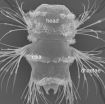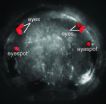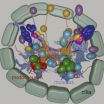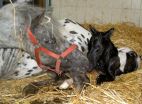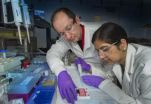(Press-News.org) This news release is available in German.
Larvae of the marine bristle worm Platynereis dumerilii orient themselves using light. Early in their development, these larvae swim towards the light to use surface currents for their dispersal. Older larvae turn away from the light and swim to the sea floor where they develop into adult worms. Scientists of the Max Planck Institute for Developmental Biology in Tübingen have discovered that this change in the behavioural response to light is coupled to different neuronal systems underlying the eyes. The scientists have reconstructed the first neuronal map of a visual system, from the input of the light stimulus up to the behavioural reaction - the directional turning of the swimming larva. Using this neuronal map, the biologists can glimpse the evolution of vision.
Phototaxis, the movement towards or away from a light source, is widespread among marine invertebrate larvae. During their development, many larvae switch from positive (movement towards light) to negative phototaxis. The underlying mechanism of phototaxis has to date only been described for the early larval stage of Platynereis dumerilii. Later in their development, the larvae develop additional eyes. With these new eyes comes the ability to switch between positive and negative phototaxis. "Instead of only swimming towards the light, the larvae often display negative phototaxis and swim away from the light", said Gáspár Jékely, head of the research group "Neurobiology of Marine Zooplankton".
During the first two days of their life, the offspring of the bristle worm has the simplest eyes on the planet: On each side of the tiny head is a single photoreceptor cell together with one shading pigment cell. In 2008, Jékely and his co-workers from the European Molecular Biology Laboratory (EMBL) in Heidelberg discovered that this photoreceptor cell is directly connected to the larval driving engine, a band of cilia, a collar directly located below the headregion. When light hits the photoreceptor cell, larvae propel ahead in spirals, always towards the source of the stimulus.
However, after 3 days of development, these simple larval eyes no longer mediate phototaxis. At this stage, two pairs of more sophisticated eyes appear on the upper side of the head – the precursors of the adult eyes. These new eyes consist of several photoreceptor cells, a pigment cup and even a simple lens. Moreover, a simple neuronal network develops that processes and transduces light stimuli.
The scientists in Jékely's team studied this neuronal network in a greater detail using an electron-microscope. In a detailed map of the visual neuronal network of a 3 day old larva they identified 71 neurons that are connected by more than 1000 neuronal connections, so-called synapses. The scientists found that the light signal is still transmitted to the cilia, but now it also reaches the larval body musculature. Moreover, the eyes from the two body sides are also connected at the neuronal level.
"We could show with behavioural experiments that the light stimulus activates the body musculature in such a way that it causes the larva to turn away from the light", says Nadine Randel, first author of the study. During the experiment, the 3 day old larvae swam in a transparent container and were illuminated only from one side. As a result, the larvae bent their body and swam in a curve away from the light. The scientists also pharmacologically blocked the neuronal communication between photoreceptor cells and musculature. Although these treated animals could still swim normally, they no longer reacted to the light source.
The neuronal connections between the eyes on either side of the body are required for spatial resolution. Additionally, the scientists could identify certain neurons, which block the signal of the photoreceptor cell from the opposite sides of the larva. "This enhances the contrast between light and dark and improves phototaxis", explains Randel.
For the first time, the developmental biologists from Tübingen describe a complete neuronal network of a simple visual system from the stimulus to the behavioral output. They also further gained deeper insights into the evolution of eyes. The simple eyes, which mediate phototaxis in the early larva, consist of two cells corresponding to Charles Darwin's idea of the "proto-eye", the precursor of all existing eyes. The four eyes which appear in the 3 day old larva represent an advanced form of this proto-eye principle. "It is as if we could observe several steps of eye evolution in a single animal", says Jékely. "We think that the first eyes probably evolved to perform phototaxis – later, eyes evolved that could recognize objects".
Probably, the first simple eyes in evolution could merely discriminate a bright from a dark field. Such eyes might nonetheless represent the starting point for the evolution of more complex visual systems, as for example the human eyes.
INFORMATION:
Original Publication:
Nadine Randel, Albina Asadulina, Luis A. Bezares- Calderón, Csaba Verasztó. Elisabeth A. Williams, Markus Conzelmann, Réza Shahidi, Gáspár Jékely: Neuronal connectome of a sensory-motor circuit for visual navigation. eLife 2014;10.7554/eLife.02730
Eye evolution: A snapshot in time
Scientists of the Max Planck Institute are studying the visual system of marine annelids to gain insights into the evolution of eyes
2014-06-11
ELSE PRESS RELEASES FROM THIS DATE:
Foaling mares are totally relaxed -- no stress
2014-06-11
Foaling in horses is extremely fast. Labour and the active part of foaling, resulting in delivery of the foal, take 10 to 20 minutes and are considerably shorter than giving birth in humans or in cows. Is this brief period stressful for the animals or are horses more relaxed than humans when giving birth? This issue has been addressed by Christina Nagel and colleagues, who closely observed 17 foalings at the Brandenburg State Stud in Neustadt (Dosse), Germany, as well as recording electrocardiograms before, during and after foaling. The researchers also took samples of ...
Making new species without sex
2014-06-11
This news release is available in German. Occasionally, two different plant species interbreed with each other in nature. This usually causes problems since the genetic information of both parents does not match. But sometimes nature uses a trick. Instead of passing on only half of each parent's genetic material, both plants transmit the complete information to the next generation. This means that the chromosome sets are totted up. The chromosomes are then able to find their suitable partner during meiosis, a type of cell division that produces an organism's reproductive ...
Having authoritarian parents increases the risk of drug use in adolescents
2014-06-11
Alcohol, tobacco and cannabis use is very widespread among youths in Spain compared to the majority of European countries, according to the latest data from the European Monitoring Centre for Drugs and Drug Addiction.
An international team, led by the European Institute of Studies on Prevention (IREFREA) with headquarters in Mallorca, together with other European and Spanish universities (Oviedo, Santiago de Compostela and Valencia), has analysed the role that parents play at the time of determining the risk of their children using alcohol, tobacco and cannabis in six ...
Herpes infected humans before they were human
2014-06-11
Researchers at the University of California, San Diego School of Medicine have identified the evolutionary origins of human herpes simplex virus (HSV) -1 and -2, reporting that the former infected hominids before their evolutionary split from chimpanzees 6 million years ago while the latter jumped from ancient chimpanzees to ancestors of modern humans – Homo erectus – approximately 1.6 million years ago.
The findings are published in the June 10 online issue of Molecular Biology and Evolution.
"The results help us to better understand how these viruses evolved and found ...
Canadian physicians lack knowledge and confidence about breastfeeding
2014-06-11
OTTAWA, Ontario – June 11, 2014 –The results of a national research project to assess breastfeeding knowledge, confidence, beliefs, and attitudes of Canadian physicians are available today in the Journal of Human Lactation.
"Physicians' attitudes and recommendations are known to directly impact the duration that a mom breastfeeds," said Dr. Catherine Pound, pediatrician and lead author of the study at the Children's Hospital of Eastern Ontario (CHEO). "Worldwide healthcare organizations readily promote the benefits of breastfeeding, and yet now we find a gap exists where ...
Researchers identify regulation process of protein linked to bipolar disorder
2014-06-11
BOSTON (June 11, 2014) — Researchers from Tufts have gained new insight into a protein associated with bipolar disorder. The study, published in the June 3 issue of Science Signaling, reveals that calcium channels in resting neurons activate the breakdown of Sp4, which belongs to a class of proteins called transcription factors that regulate gene expression.
This study, led by Grace Gill, identifies a molecular mechanism regulating Sp4 activity. Her previous research had determined that reduced levels of Sp4 in the brain are associated with bipolar disorder. Her work ...
DNA-linked nanoparticles form switchable 'thin films' on a liquid surface
2014-06-11
UPTON, NY—Scientists seeking ways to engineer the assembly of tiny particles measuring just billionths of a meter have achieved a new first—the formation of a single layer of nanoparticles on a liquid surface where the properties of the layer can be easily switched. Understanding the assembly of such nanostructured thin films could lead to the design of new kinds of filters or membranes with a variable mechanical response for a wide range of applications. In addition, because the scientists used tiny synthetic strands of DNA to hold the nanoparticles together, the study ...
Scientists unravel the genetic secrets of nature's master of mimicry
2014-06-11
Scientists investigating how one of the greatest shape shifters in the natural world is able to trick predators to avoid being eaten have identified the gene behind the fascinating feat.
The African Swallowtail butterfly, also known as the 'Mocker Swallowtail' or the 'Flying Handkerchief,' can appear to change both colour and shape.
Males of the species fly boldly around the tree tops, their rapid flight making them look like shaking handkerchiefs, however females lurk in the bushes and pretend to be examples of Monarch butterflies that are nasty to eat.
The females ...
Infant nutrition and development of type 1 diabetes
2014-06-11
Previous studies have indicated that early exposure to complex foreign proteins, such as cow's milk proteins, increases the risk of type 1 diabetes in predisposed individuals.
"Therefore, In 2002, we embarked on a large-scale study on more than 2100 infants with a family member affected by type 1 diabetes and with genetic disease susceptibility to find an answer to the question whether delaying the exposure to complex foreign proteins will decrease the risk of diabetes", tells Professor Mikael Knip from the University of Helsinki, the leader of the TRIGR Study.
After ...
New guidance on how and when to stop immunosuppressants in lupus patients
2014-06-11
A new study presented today at the European League Against Rheumatism Annual Congress (EULAR 2014) showed that, for the majority of lupus patients who are in remission, it is possible to successfully stop immunosuppressant therapy without triggering a flare of their disease.1 Within two years, it was possible to stop the immunosuppressant in about 70% of clinically stable patients. Half were successful within three years, and this proportion remained stable for up to five years.1
Lupus is a chronic inflammatory disease that can affect any organ system, but mainly involves ...
LAST 30 PRESS RELEASES:
Singapore scientists discover lung cancer's "bodyguard system" - and how to disarm it
Bacteria use wrapping flagella to tunnel through microscopic passages
New critique prompts correction of high-profile Yellowstone aspen study, highlighting challenges in measuring ecosystem response to wolf reintroduction
Stroke survivors miss critical treatment, face greater disability due to systemic transfer delays
Delayed stroke care linked to increased disability risk
Long term use of anti-acid drugs may not increase stomach cancer risk
Non-monetary 'honor-based' incentives linked to increased blood donations
Natural ovulation as effective as hormones before IVF embryo transfer
Major clinical trial provides definitive evidence of impacts of steroid treatment on severe brain infection
Low vitamin D levels shown to raise risk of hospitalization with potentially fatal respiratory tract infections by 33%
Diagnoses of major conditions failing to recover since the pandemic
Scientists solve 66 million-year-old mystery of how Earth’s greenhouse age ended
Red light therapy shows promise for protecting football players’ brains
Trees — not grass and other greenery — associated with lower heart disease risk in cities
Chemical Insights scientist receives Achievement Award from the Society of Toxicology
Breakthrough organic crystalline material repairs itself in extreme cold temperatures, unlocking new possibilities for space and deep-sea technologies
Scientists discover novel immune ‘traffic controller’ hijacked by virus
When tropical oceans were oxygen oases
Positive interactions dominate among marine microbes, six-year study reveals
Safeguarding the Winter Olympics-Paralympics against climate change
Most would recommend RSV immunizations for older and pregnant people
Donated blood has a shelf life. A new test tracks how it's aging
Stroke during pregnancy, postpartum associated with more illness, job status later
American Meteorological Society announces new executive director
People with “binge-watching addiction” are more likely to be lonely
Wild potato follows a path to domestication in the American Southwest
General climate advocacy ad campaign received more public engagement compared to more-tailored ad campaign promoting sustainable fashion
Medical LLMs may show real-world potential in identifying individuals with major depressive disorder using WhatsApp voice note recordings
Early translational study supports the role of high-dose inhaled nitric oxide as a potential antimicrobial therapy
AI can predict preemies’ path, Stanford Medicine-led study shows
[Press-News.org] Eye evolution: A snapshot in timeScientists of the Max Planck Institute are studying the visual system of marine annelids to gain insights into the evolution of eyes
